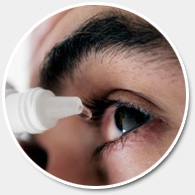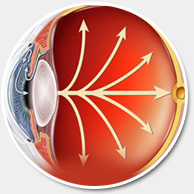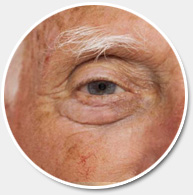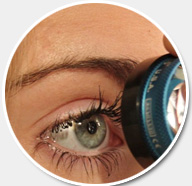
Glaucoma is not just one eye disease, but a group of eye conditions resulting in optic nerve damage, which may cause loss of vision. Abnormally high pressure inside your eye (intraocular pressure) usually, but not always, causes this damage.
Glaucoma is one of the leading causes of blindness in the United States. Glaucoma can damage your vision so gradually you may not notice any loss of vision until the disease is at an advanced stage. The most common type of glaucoma, primary open-angle glaucoma, has no noticeable signs or symptoms except gradual vision loss.
Early diagnosis and treatment can minimize or prevent optic nerve damage and limit glaucoma-related vision loss. It's important to get your eyes examined regularly, and make sure your eye doctor measures your intraocular pressure.
• Symptoms
The most common types of glaucoma — primary open-angle glaucoma and angle-closure glaucoma — have completely different symptoms.
Primary open-angle glaucoma signs and symptoms include:
- Gradual loss of peripheral vision, usually in both eyes
- Tunnel vision in the advanced stages
 Acute angle-closure glaucoma signs and symptoms include: Acute angle-closure glaucoma signs and symptoms include:
- Eye pain
- Nausea and vomiting (accompanying the severe eye pain)
- Sudden onset of visual disturbance, often in low light
- Blurred vision
- Halos around lights
- Reddening of the eye
Both open-angle and angle-closure glaucoma can be primary or secondary conditions. They're called primary when the cause is unknown and secondary when the condition can be traced to a known cause, such as eye injury, medications, certain eye conditions, inflammation, tumor, advanced cataract or diabetes. In secondary glaucoma, the signs and symptoms can include those of the primary condition as well as typical glaucoma symptoms.
• Causes
For reasons that doctors don't fully understand, increased pressure within the eye (intraocular pressure) is usually, but not always, associated with the optic nerve damage that characterizes glaucoma. This pressure is due to a buildup of a fluid (aqueous humor) that flows in and out of your eye.
This fluid normally exits your eye through a drainage system at the angle where the iris and the cornea meet. When the drainage system doesn't work properly, the fluid can't filter out of the eye at its normal rate, and pressure builds within your eye.
1) Primary open-angle glaucoma
In primary open-angle glaucoma, the drainage angle formed by the cornea and the iris remains open, but the drainage channels (trabecular meshwork) in the angle are partially blocked, causing the fluid to drain out of the eye too slowly. This causes fluid to back up in your eye, and pressure gradually increases within your eye.
Damage to the optic nerve doesn't cause symptoms or pain, and it happens so slowly that you may lose an extensive amount of vision before you're even aware of a problem. The exact cause of primary open-angle glaucoma remains unknown.
 2) Angle-closure glaucoma 2) Angle-closure glaucoma
Angle-closure glaucoma, also called closed-angle glaucoma, occurs when the iris bulges forward to narrow or block the drainage angle formed by the cornea and the iris. As a result, fluid can't adequately flow through and exit your eye, and your eye pressure may increase abruptly. Angle-closure glaucoma usually occurs suddenly (acute angle-closure glaucoma), but it can also occur gradually (chronic angle-closure glaucoma).
Some people with an abnormally narrow drainage angle may be at risk of developing angle-closure glaucoma.
If you have a narrow drainage angle, sudden dilation of your pupils may trigger acute angle-closure glaucoma.
3) Normal-tension glaucoma
In normal-tension glaucoma, your optic nerve becomes damaged. However, your eye pressure remains within the normal range. Doctors don't understand why this occurs. You may have a sensitive optic nerve, or you may have less blood being supplied to your optic nerve. This lack of blood supply could be caused by atherosclerosis — an accumulation of fatty deposits (plaques) in the arteries — or another condition limiting your blood circulation.
4) Developmental glaucoma
Some infants or children may be diagnosed with glaucoma. Rarely, some children may be born with glaucoma (congenital glaucoma), develop glaucoma in the first few years of life (infantile glaucoma) or develop glaucoma after age 4 or 5 (juvenile glaucoma). Children usually won't have any symptoms. However, they have optic nerve damage, which may be caused by angle blockages or malformations (primary infantile glaucoma), or it could develop as the result of other conditions (secondary glaucoma).
 5) Pigmentary glaucoma 5) Pigmentary glaucoma
In pigmentary glaucoma, pigment granules from your iris build up in the drainage channels (trabecular meshwork), slowing or blocking fluid exiting your eye. Physical activities, such as jogging, sometimes stir up the pigment granules, depositing them on the trabecular meshwork and causing intermittent pressure elevations.
• Risk factors
Because chronic forms of glaucoma can destroy vision before any signs or symptoms are apparent, be aware of these factors:
- Elevated internal eye pressure (intraocular pressure). If your internal eye pressure (intraocular pressure) is higher than normal, you're at increased risk of developing glaucoma, though not everyone with elevated intraocular pressure develops the disease.
- Age. You're at a higher risk of glaucoma if you're older than age 60, particularly if you're Mexican-American. You may be at higher risk of angle-closure glaucoma if you're older than age 40. For certain groups such as African-Americans, however, the risk of developing glaucoma is much higher and occurs at a younger age than that of other groups. If you're African-American, ask your doctor when you should start having regular comprehensive eye exams.
 Ethnic background. African-Americans older than age 40 have much higher risk of developing glaucoma than do whites (Caucasians). African-Americans also are more likely to experience permanent blindness as a result of glaucoma. People of Asian descent have an increased risk of developing acute angle-closure glaucoma. People of Japanese descent may be more likely to have normal-tension glaucoma. Ethnic background. African-Americans older than age 40 have much higher risk of developing glaucoma than do whites (Caucasians). African-Americans also are more likely to experience permanent blindness as a result of glaucoma. People of Asian descent have an increased risk of developing acute angle-closure glaucoma. People of Japanese descent may be more likely to have normal-tension glaucoma.
- Family history of glaucoma. If you have a family history of glaucoma, you have a greater risk of developing it. Glaucoma may have a genetic link, meaning there's a defect in one or more genes that may cause certain individuals to be more susceptible to the disease. A form of juvenile open-angle glaucoma has been clearly linked to genetic abnormalities.
- Medical conditions. Several conditions may increase your risk of developing glaucoma, including diabetes, heart diseases, high blood pressure and hypothyroidism.
- Other eye conditions. Severe eye injuries can cause increased eye pressure. Other eye conditions that could cause increased risk of glaucoma include eye tumors, retinal detachment, eye inflammation and lens dislocation. Certain types of eye surgery also may trigger glaucoma. Also, being nearsighted or farsighted may increase your risk of developing glaucoma.
- Long-term corticosteroid use. Using corticosteroid medications, especially eyedrops for a long period of time may increase your risk of developing secondary glaucoma.

Complications
If left untreated, glaucoma will cause progressive vision loss, normally in these stages:
- Blind spots in your peripheral vision
- Tunnel vision
- Total blindness
|